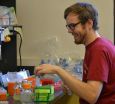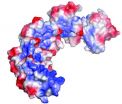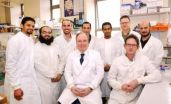(Press-News.org) Wikipedia lists 65 adjectives that botanists use to describe the shapes of plant leaves. In English (rather than Latin) they mean the leaf is lance-shaped, spear-shaped, kidney-shaped, diamond shaped, arrow-head-shaped, egg-shaped, circular, spoon-shaped , heart-shaped, tear-drop-shaped or sickle-shaped — among other possibilities.
How does the plant "know" how to make these shapes? The answer is by controlling the distribution of a plant hormone called auxin, which determines the rate at which plant cells divide and lengthen.
But how can one molecule make so many different patterns? Because the hormone's effects are mediated by the interplay between large families of proteins that either step on the gas or put on the brake when auxin is around.
In recent years as more and more of these proteins were discovered, the auxin signaling machinery began to seem baroque to the point of being unintelligible.
Now the Strader and Jez labs at Washington University in St. Louis have made a discovery about one of the proteins in the auxin signaling network that may prove key to understanding the entire network.
In the March 24 issue of the Proceedings of the National Academy of Sciences they explain that they were able to crystallize a key protein called a transcription factor and work out its structure. The interaction domain of the protein, they learned, folds into a flat paddle with a positively charged face and a negatively charged face. These faces allow the proteins to snap together like magnets, forming long chains, or oligomers.
We have some evidence that proteins chain in plant cells as well as in solution, said senior author Lucia Strader, PhD, assistant professor of biology and an auxin expert. By varying the length of these chains, plants may fine-tune the response of individual cells to auxin to produce detailed patterns such as the toothed lobes of the cilantro leaf.
Combinatorial explosion
Sculpting leaves is just one of many roles auxin plays in plants. Among other things the hormone helps make plants bend toward the light, roots grow down and shoots grow up, fruits develop and fruits fall off.
"The most potent form of the hormone is indole-3-acetic acid, abbreviated IAA, and my lab members joke that IAA really stands for Involved in Almost Everything," Strader said.
The backstory here is that whole families of proteins intervene between auxin and genes that respond to auxin by making proteins. In the model plant Aribidopsis thaliana these include 5 transcription factors that activate genes when auxin is present (called ARFs) and 29 repressor proteins that block the transcription factors by binding to them (Aux/IAA proteins). A third family marks repressors for destruction.
"Different combinations of these proteins are present in each cell," said Strader. "On top of that, some combinations interact more strongly than others and some of the transcription factors also interact with one another."
In an idle moment David Korasick, a graduate fellow in the Strader and Jez labs and first author on the PNAS article, did a back-of-the-envelope calculation to put a number on the complexity of the system they were trying to understand. From a strictly mathematical point of view there are 3,828 possible combinations of the auxin-related Arabidopsis proteins. That is assuming interactions involve only one of each type of protein; if multiples are possible, the number, of course, explodes.
To make any headway, Strader said, we had a better understanding of how these proteins interact. The rule in protein chemistry is the opposite of the one in design: instead of form following function, function follows form.
So to figure out a protein's form — the way it folds in space — they turned to the Jez lab, which specializes in protein crystallography, essentially a form of high-resolution microscopy that allows protein structures to be visualized at the atomic level.
Korasick had the job of crystallizing ARF7, a transcription factor that helps, Arabidopsis bend toward the light. With the help of Joseph Jez, PhD, associate professor of biology, Corey Westfall, and Soon Goo Lee), Korasick cut "floppy bits" off the protein that might have made it hard to crystallize, leaving just the part of the protein where it interacts with repressor molecules.
After he had that construct, crystallization was remarkably fast. He set up his first drops in solution wells on the 4th of July. The protein crystallized with a fuss, and he ran the crystals up to the Advanced Photon Source at the Argonne National Laboratory outside Chicago. By August 1 he had the diffraction data he needed to solve the protein's structure.
Surprise, surprise
The previous model for the interaction between a repressor and a transcription factor – a model that had stood for 15 years, Strader said– was that the repressor lay flat on the transcription factor, two domains on the repressor matching up with the corresponding two domains on the transcription factor.
The structural model Korasick developed showed that the two domains fold together to form a single domain, called a PB1 domain. A PB1 domain is a protein interaction module that can be found in animals and fungi as well as plants.
Strader, Jez et al.
The transcription factor ARF7 turned out to have a magnet-like interaction region, called a PB1 domain ,with positively (blue) and negatively (red) charged faces.
The repressor proteins, which are predicted to have PB1 domains identical to that of the ARF transcription factor, then stick to one or the other side of the transcription factor's PB1 domain, preventing it from doing its job. Experiments showed that there had to be a repressor protein stuck to both faces of the transcription factor's PB1 domain to repress the activity of auxin.
This means the model, which pairs a single repressor protein with a single transcription factor, is wrong, Strader said.
"Nor can we limit the interactions to just two," she said. "It could be hundreds for all we know."
In Korasick's crystal five of the ARF7 PB1 domains stuck to one another, forming a pentamer.
"I like to think of the PB1 domains as magnets, " Strader said. "Like magnets, they can stick together, back-to-front, to form long chains."
"But we have to put an asterisk next to that," Korasick said, "because it's possible it's an artifact of crystallography and doesn't work that way in living plants."
But both Strader and Korasick suspect that it does. Strader points out that the complexity of the auxin signaling system has increased over evolutionary time as plants became fancier. A simple plant like the moss Physcomitrella patens has fewer signaling proteins than a complicated plant like soybean.
"Probably what that's saying is that it's really, really important for a plant to be able to modulate auxin signaling, to have the right amount in each cell, to balance positive and negative growth," Korasick said.
"The difference between plants and animals," said Strader, "is that plants have rigid cell walls. So when a plant cell decides to divide itself or length itself, that's a permanent decision, which is why it's so tightly controlled."
INFORMATION: END
Scientists find a molecular clue to the complex mystery of auxin signaling in plants
Interaction domain on proteins that modulate this potent hormone allows them to stack back-to-front like button magnets
2014-03-25
ELSE PRESS RELEASES FROM THIS DATE:
Innovative technique provides inexpensive, rapid and detailed analysis of proteins
2014-03-25
Proteins are vital participants in virtually all life processes, including growth, repair and signaling in cells; catalysis of chemical reactions and defense against infection. For these reasons, proteins can provide critical signposts of health and disease, provided they can be identified and assessed in a clinical setting.
Accurately characterizing proteins for diagnostic and therapeutic purposes has been an enormous challenge for the medical community. At the Biodesign Institute's Molecular Biomarkers Laboratory at Arizona State University, research focuses on the ...
Researchers take mathematical route to fighting viruses
2014-03-25
Mathematicians at the University of York have joined forces with experimentalists at the University of Leeds to take an important step in discovering how viruses make new copies of themselves during an infection.
The researchers have constructed a mathematical model that provides important new insights about the molecular mechanisms behind virus assembly which helps to explain the efficiency of their operation.
The discovery opens up new possibilities for the development of anti-viral therapies and could help in the treatment of a range of diseases from HIV and Hepatitis ...
A new concept for manufacturing wrinkling patterns on hard nano-film/soft-matter substrate
2014-03-25
Wrinkling is a common phenomenon for thin stiff film adhered on soft substrate. Various wrinkling phenomenon has been reported previously. Wu Dan, Yin Yajun, Xie Huimin,et al from Tsinghua University proposed a new method to control wrinkling and buckling of thin stiff film on soft substrate. It is found that the curve pattern on the soft substrate has obvious influence on the wrinkling distribution of the thin film/soft substrate. Their work, entitled "Controlling the surface buckling wrinkles by patterning the material system of hard-nano-film/soft-matter-substrate", ...
Psychiatric complications in women with PCOS often linked to menstrual irregularity
2014-03-25
(NEW YORK, NY, March 24, 2014) – Polycystic ovary syndrome (PCOS), a hormone imbalance that causes infertility, obesity, and excessive facial hair in women, can also lead to severe mental health issues including anxiety, depression, and eating disorders. A study supervised by Columbia University School of Nursing professor Nancy Reame, MSN, PhD, FAAN, and published in the Journal of Behavioral Health Services & Research, identifies the PCOS complications that may be most responsible for psychiatric problems. While weight gain and unwanted body hair can be distressing, irregular ...
Shorter sleepers are over-eaters
2014-03-25
Young children who sleep less eat more, which can lead to obesity and related health problems later in life, reports a new study by UCL researchers.
The study found that 16 month-old children who slept for less than 10 hours each day consumed on average 105kcal more per day than children who slept for more than 13 hours. This is an increase of around 10% from 982kcal to 1087kcal.
Associations between eating, weight and sleep have been reported previously in older children and adults, but the study, published in the International Journal of Obesity, is the first to directly ...
Instant immune booster dramatically improves outcome of bacterial meningitis and pneumonia
2014-03-25
AUDIO:
This is a podcast interview with Professor Schwaeble.
Click here for more information.
"I am really excited about this landmark discovery. We demonstrate that boosting the innate immune system can have a significant impact on the body's ability to defend itself against life-threatening infections" - Professor Wilhelm Schwaeble from the University of Leicester's Department of Infection, Immunity and Inflammation
IMAGES AND A PODCAST INTERVIEW WITH PROFESSOR SCHWAEBLE ...
Protein plays key role in infection by oral pathogen
2014-03-25
CAMBRIDGE, Mass., March 24 — Scientists at Forsyth, along with a colleague from Northwestern University, have discovered that the protein, Transgultaminase 2 (TG2), is a key component in the process of gum disease. TG2 is widely distributed inside and outside of human cells. The scientists found that blocking some associations of TG2 prevents the bacteria Porphyromonas gingivalis (PG) from adhering to cells. This insight may one day help lead to novel therapies to prevent gum disease caused by PG.
Periodontal, or gum, disease is one of the most common infectious diseases. ...
Studying crops, from outer space
2014-03-25
Washington, D.C.— Plants convert energy from sunlight into chemical energy during a process called photosynthesis. This energy is passed on to humans and animals that eat the plants, and thus photosynthesis is the primary source of energy for all life on Earth. But the photosynthetic activity of various regions is changing due to human interaction with the environment, including climate change, which makes large-scale studies of photosynthetic activity of interest. New research from a team including Carnegie's Joe Berry reveals a fundamentally new approach for measuring ...
Violent video games associated with increased aggression in children
2014-03-25
Bottom Line: Habitually playing violent video games appears to increase aggression in children, regardless of parental involvement and other factors.
Author: Douglas A. Gentile, Ph.D., of Iowa State University, Ames, and colleagues.
Background: More than 90 percent of American youths play video games, and many of these games depict violence, which is often portrayed as fun, justified and without negative consequences.
How the Study Was Conducted: The authors tracked children and adolescents in Singapore over three years on self-reported measures of gaming habits, ...
E-cigarettes not associated with more smokers quitting, reduced consumption
2014-03-25
Bottom Line: The use of electronic cigarettes (e-cigarettes) by smokers is not associated with greater rates of quitting cigarettes or reduced cigarette consumption after one year.
Author: Rachel A. Grana, Ph.D., M.P.H., and colleagues from the University California, San Francisco.
Background: E-cigarettes are promoted as smoking cessation tools, but studies of their effectiveness have been unconvincing.
How the Study Was Conducted: The authors analyzed self-reported data from 949 smokers (88 of the smokers used e-cigarettes at baseline) to determine if e-cigarettes ...
LAST 30 PRESS RELEASES:
Receptors in mammary glands make livestock and humans inviting hosts for avian flu
Icy hot plasmas
Treating adults with autism: Maryland Clinical Center offers national blueprint for care after pediatric transition
University of Phoenix College of Doctoral Studies releases white paper on reclaiming control to build workforce resilience
NCCN Summit seeks to improve care for veterans and first responders with cancer from line-of-duty exposure
ERC Consolidator Grant for soft robotics researcher
Dual-action arts and wellbeing program transforms dementia care
The global plastic waste trade contributes to coastal litter in importing countries, study shows
UT Dallas partners with Tech Mahindra on AI innovation
Blinking less could signal the brain is working harder to listen, Concordia study shows
Male bonobos track females’ reproductive cycle to maximize mating success
New report outlines science priorities for human Mars exploration
Want to curb cannabis-related crashes? Don’t forget older adults, study finds
Expectant management vs medication for patent ductus arteriosus in preterm infants
Pew funds 7 new biomedical research collaborations
The ERC selects 349 mid-career researchers for €728 million in Consolidator Grants
ERC Consolidator Grant awarded to CISPA researcher Rayna Dimitrova
Antimicrobial effects of Syzygium aromaticum and Salvadora persica against common peri-implantitis pathogens in vitro
EVs pose no greater risk to pedestrians than conventional vehicles
Modeling microplastic accumulation under the ocean surface
Pompeii offers insights into ancient Roman building technology
University of Utah engineers give a bionic hand a mind of its own
Transient and long-term risks of common physical activities in people with low back pain
Health care contact days in older adults with metastatic cancer
Brain resilience science reshapes psychiatry from treating illness to building strength
An assessment of the antidepressant potential of deramciclane in two animal tests
Pitt and UPMC study finds epigenetic signature of pediatric traumatic brain injury, paves way for precision recovery tools
Brain discovery opens door to earlier detection of metabolic syndrome in women
SwRI-led study provides insight into oscillations in solar flares
Announcing the third cohort of the Hevolution/AFAR new investigator awards in aging biology and geroscience research
[Press-News.org] Scientists find a molecular clue to the complex mystery of auxin signaling in plantsInteraction domain on proteins that modulate this potent hormone allows them to stack back-to-front like button magnets






